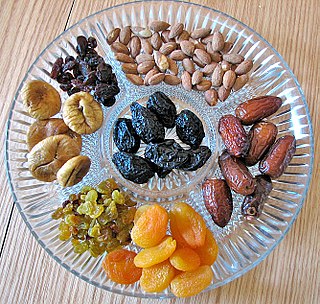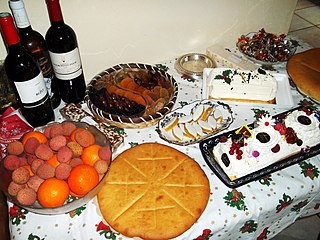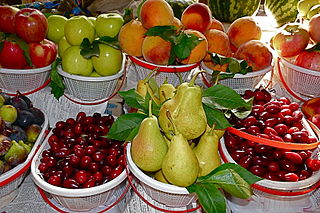
A fruit tree is a tree which bears fruit that is consumed or used by animals and humans — all trees that are flowering plants produce fruit, which are the ripened ovaries of flowers containing one or more seeds. In horticultural usage, the term "fruit tree" is limited to those that provide fruit for human food. Types of fruits are described and defined elsewhere, but would include "fruit" in a culinary sense, as well as some nut-bearing trees, such as walnuts.

Table grapes are grapes intended for consumption while fresh, as opposed to grapes grown for wine production, juice production, or for drying into raisins.

Dried fruit is fruit from which the majority of the original water content has been removed either naturally, through sun drying, or through the use of specialized dryers or dehydrators. Dried fruit has a long tradition of use dating back to the fourth millennium BC in Mesopotamia, and is prized because of its sweet taste, nutritive value, and long shelf life.

Pomology is a branch of botany that studies fruits and their cultivation. Someone who researches and practices the science of pomology is called a pomologist. The term fruticulture is also used to describe the agricultural practice of growing fruits in orchards.

Five Alive is a line of fruit juice blends created by Minute Maid, a subsidiary of The Coca-Cola Company. Both the name and the five colors of the logo refer to the five fruit juices each variety contains.

Iraqi cuisine is a Middle Eastern cuisine that has its origins in the ancient Near East culture of the fertile crescent. Tablets found in ancient ruins in Iraq show recipes prepared in the temples during religious festivals—the first cookbooks in the world. Ancient Mesopotamia was home to a sophisticated and highly advanced civilization, in all fields of knowledge, including the culinary arts.
Flavored liquors are liquors that have added flavoring and, in some cases, a small amount of added sugar. They are distinct from liqueurs in that liqueurs have a high sugar content and may also contain glycerine.

Spoon sweets are sweet preserves, served in a spoon as a gesture of hospitality in Bosnia, Serbia, Albania, Greece, Turkey, Kosovo, Cyprus, the Balkans, parts of the Middle East, and Russia. They can be made from almost any fruit, though sour and bitter fruits are especially prized. There are also spoon sweets produced without fruit.

Roughly one-third of Iran's total surface area is suited for farmland, but because of poor soil and lack of adequate water distribution in many areas, most of it is not under cultivation. Only 12% of the total land area is under cultivation but less than one-third of the cultivated area is irrigated; the rest is devoted to dryland farming. Some 92 percent of agricultural products depend on water. The western and northwestern portions of the country have the most fertile soils. Iran's food security index stands at around 96 percent.
Agriculture in Central Asia provides a brief regional overview of agriculture in the five contiguous states of former Soviet Central Asia – Kazakhstan, Kyrgyzstan, Tajikistan, Turkmenistan, and Uzbekistan. Two other countries that are sometimes classified as Central Asian – Afghanistan and Mongolia – are included in this overview because of their substantially different background.

Haft Seen or Haft sin is an arrangement of seven symbolic items which names start with the letter "س", the 15th letter in the Persian alphabet; "haft" (هفت) is Persian for "seven". It is traditionally displayed at Nowruz, the Iranian New Year, which is celebrated on the day of the vernal equinox, marking the beginning of spring in the Northern Hemisphere.

Tajik cuisine is a traditional cuisine of Tajikistan, and has much in common with Russian, Afghan, Iranian and Uzbek cuisines. Plov (pilaf), also called osh, is the national dish in Tajikistan, as in other countries in the region. Green tea is the national drink.

The thirteen desserts are the traditional dessert foods used to celebrate Christmas in the French region of Provence. The "big supper" ends with a ritual 13 desserts, representing Jesus Christ and the 12 apostles. The desserts always number thirteen but the exact items vary by local or familial tradition. The food traditionally is set out Christmas Eve and remains on the table three days until December 27.

A Tu BiShvat seder is a festive ceremony, often accompanied by a meal featuring fruits in honor of the Jewish holiday of Tu BiShvat.

Armenia has 2.1 million hectares of agricultural land, 72% of the country's land area. Most of this, however, is mountain pastures, and cultivable land is 480,000 hectares, or 16% of the country's area. In 2006, 46% of the work force was employed in agriculture, and agriculture contributed 21% of the country's GDP. In 1991 Armenia imported about 65 percent of its food.

Agriculture in Portugal is based on small to medium-sized family-owned dispersed units; however, the sector also includes larger-scale intensive farming export-oriented agrobusinesses backed by companies. The extent of cooperative organisation has been reaching a greater importance with globalization. Portugal produces a wide variety of products, including green vegetables, rice, corn, wheat, barley, olives, oilseeds, nuts, cherries, bilberry, table grapes and edible mushrooms. Forestry has also played an important economic role among the rural communities and industry. In 2013, the gross agricultural product accounted for 2.4% of the GDP. Portugal is the largest world producer of both cork and carob, as well as the third largest exporter of chestnut and the third largest European producer of pulp. Portugal is among the top ten largest olive oil producers in the world and is the fourth biggest exporter. The country is also one of the world's largest exporters of wine, being reputed for its fine wines. The land area of slightly more than 9.2 million hectares was classified as follows : 2,755 arable land and permanent crops, 530 permanent pasture, 3,640 forest and woodland, and 2,270 other land.

Sharbat is a drink prepared from fruit or flower petals. It is a sweet cordial, and usually served chilled. It can be served in concentrated form and eaten with a spoon or diluted with water to create the drink.
The fruit sector in Azerbaijan is a developing industry. The sector covered 171,600 ha. of land in 2016. Grape, apple, orange, pear and pomegranate are one of the major crops in fruit production in Azerbaijan.
















